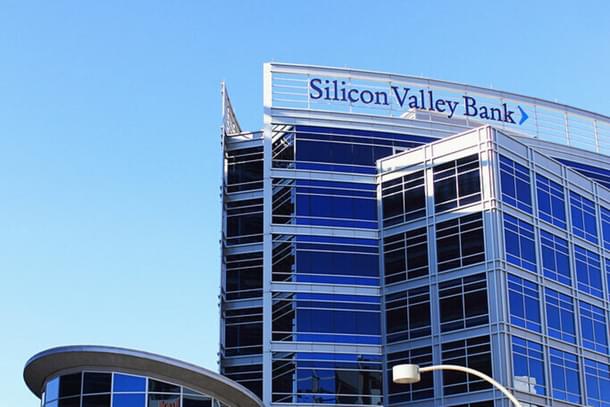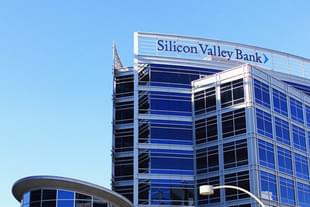Business
Why Silicon Valley Bank Was Shuttered By US Regulators
Business Briefs
Mar 11, 2023, 09:21 AM | Updated Mar 13, 2023, 01:14 PM IST
Save & read from anywhere!
Bookmark stories for easy access on any device or the Swarajya app.


In a swift turn of events culminating in the second-largest bank collapse in U.S. history, SVB Financial Group, which operates Silicon Valley Bank (SVB), was shuttered by U.S. regulators and its assets seized after a run on the bank on Friday (March 10).
The bank saw nearly $ 80 billion worth of shareholder value get wiped off after it initiated and then abandoned a capital raising program through equity and debt.
The crisis that enveloped SVB also triggered a global sell-off in banking stocks after it launched a rescue share sale to plug a near-$2 billion gaping hole in its finances.
"Silicon Valley Bank, Santa Clara, California, was closed today by the California Department of Financial Protection and Innovation, which appointed the Federal Deposit Insurance Corporation (FDIC) as receiver." the Federal Deposit Insurance Corporation (FDIC), the U.S. regulator that guarantees bank deposits of up to $250,000, said in a statement.
"To protect insured depositors, the FDIC created the Deposit Insurance National Bank of Santa Clara (DINB). At the time of closing, the FDIC as receiver immediately transferred to the DINB all insured deposits of Silicon Valley Bank." the statement added.
As of December 31, 2022, SVB had approximately $209.0 billion in total assets and about $175.4 billion in total deposits., the FDIC said.
The FDIC said that customers who have continued access to their insured funds beginning Monday. However, the payments to uninsured depositors FDIC will hinge on the sale of SVB assets.
It remains to be seen how much of its deposits exceeded the $250,000 insurance limit. Past regulatory reports showed that much of SVB's deposits exceeded that limit. According to SVB's own estimates in 2022, 96 per cent of its $173.1 billion in deposits exceeded or were not covered by FDIC insurance.
How Did Problems Unfold?
SVB, the nation's 16th largest bank primarily catering to Silicon Valley's start-ups, saw its deposits surge from $ 60 billion in 2019 (just before the pandemic) to more than $ 190 billion by 2022. Basically, the deposit base increased by more than triple over a period of three years.
The main reason for such an increase was the increased funding that start-ups and venture funds received. These entities would park their excess money with the bank as deposits.
Since SVB didn't want to engage in unbridled lending or simply didn't have the opportunity to lend the money, it parked a major portion of the deposit money into fixed-return mortgage-backed securities (MBS). These instruments are generally regarded as safe. Since SVB's deposits almost cost nothing, this model was profitable.
When government securities yielded 0.5 per cent, SVB managed to make 1.5 per cent – but in hindsight selecting non-floating interest rate assets was a mistake. The error was to invest in fixed-return assets at a time when interest rates were poised to rise. As a result, SVB was locked into low yields when interest rates on government securities were much higher.
SVB faces another issue as well, unlike other banks – high-interest rates would mean less investor money for risky investments like start-ups. Therefore, SVB's deposit base is likely to reduce as its clients withdraw more money than they put in during their cash burn phase.
Further, SVB primarily caters to business clientele (venture capital funds as well as tech and healthcare start-ups) that are sensitive to the interest they earn on deposits – if treasury teams are not satisfied with the yield on deposits, they will shift the money to another bank. As interest rates rise, customers would have to be given higher rates lest they park their money elsewhere.
Since the Fed increased rates quickly, MBS yields moved up to 7 per cent. But this doesn't benefit SVB since the fixed return asset's price has an inverse relation with yield – an increase in yields would mean a decrease in asset price to compensate.
While SVB might have losses on its MBS portfolio, it doesn't necessarily need to sell its assets since the MBS doesn't appear to be a low-quality asset. But, SVB still decided to sell off low-yielding fixed-return long-term assets for higher-yielding shorter-term assets that can help it keep up with the increasing cost of deposits. Since it sold its MBS assets at a loss, and to shore up its capital, it decided to.
SVB had invested its funds into mortgage-backed securities (MBS). MBS defaults were the main reason behind the 2008 financial crisis; hence, many are comparing the current crisis to the 2008 crisis. But the issue, in this case, isn't that SVB's MBS assets are defaulting, but that SVB has been unable to select the right investment or predict interest rates properly. Further, the nature of its business has made it especially vulnerable to interest rate increases. Unlike Lehman or Bear Stearns of 2008, SVB has been known for conservative lending.
In addition, other banks do not have high exposure to a business clientele, making their deposits sticky at a lower cost. Further, other banks have invested in securities with floating interest rates, allowing them to benefit from the rise in interest rates.
Unfortunately, the bad memories of MBS combined with the recent crisis at crypto lender Silvergate which went bankrupt due to bad lending practices, caused the market to panic.
Can SVB collapse cause contagion?
At this point, the collapse of SVB is unlikely to have a larger impact on the larger banking system. Also, SVB has unique vulnerabilities in a rising interest regime.
The systemically biggest banks have relatively healthy balance sheets and are well-capitalised.
The collapse, however, is likely to pose serious trouble for Silicon Valley start-ups, as it is one of the biggest lenders to start-ups and V.C. funds in the U.S.





